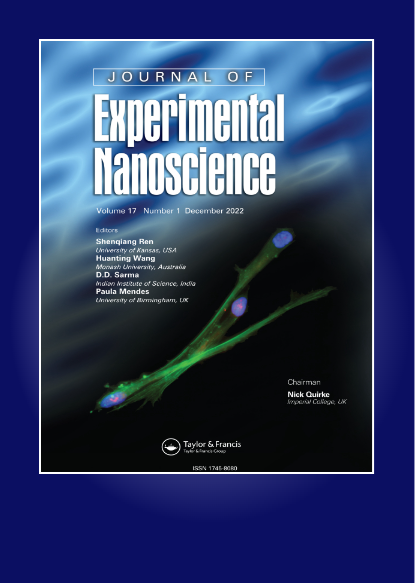New experimental low-cost nanoscience technology for formulation of silver nanoparticles-activated carbon composite as a promising antiviral, biocide, and efficient catalyst
IF 2.8
4区 材料科学
Q2 CHEMISTRY, MULTIDISCIPLINARY
引用次数: 4
Abstract
Abstract A simple low-cost one-pot photodeposition synthesis with no hazardous reactants or products is used to make silver nanoparticles-activated carbon composite (SNPs@AC). The SNPs are homogenously and photodeposited and absorbed into the activated carbon matrix. Both SNPs and SNPs@AC composite have particle sizes around 10 nm and 100 nm, respectively. The SNPs@AC composite showed good antiviral activity to VERO (ATCC ccl-81) cells. Zeta potential of SNPs@AC composite is −25 mV, showing that this colloidal system is electrically stable and resistant to coagulation. For many Gram-positive and Gram-negative bacteria, the SNPs@AC composite demonstrated strong antibacterial efficacy. The SNPs@AC composite has 75.72 percent anti-inflammatory effect at concentration 500 µg/mL. This composite has a maximum non-toxic concentration (MNTC) of 78.125 g/mL, which corresponds to antiviral activity of up to 96.7 percent against hepatitis A. virus (HAV). It is suggested as a candidate for pharmaceutical formulations, such as integration into the manufacture of N95 masks for COVID-19 infection protection. Concentration 160 μg/mL SNPs@AC composite has antioxidant activity 42.74% percent. The SNPs@AC composite exhibited selective catalytic activity for the organosynthesis hydrazination reaction of 4-chloro-3, 5-di-nitro-benzo-triflouride, giving 1-hydroxy-4-nitro-6-trifluoro-methyl benzotriazole, a common antiviral drug for severe acute respiratory syndrome (SARS). SNPs@composite's well-defined pores provide suitable active sites for binding reactants: 4-Cl-3, 5-di-NO2-benzotriflouride, and hydrazine, which react to create 1-hydroxy-4-nitro-6-trifluoromethyl benzotriazole, which diffuses into solution away from the catalyst surface, leaving the catalyst surface unaffected.新的实验性低成本纳米科学技术,用于配制银纳米颗粒-活性炭复合材料,作为一种有前途的抗病毒、杀生物剂和高效催化剂
摘要采用一种简单、低成本、无危险反应物或产物的一锅光沉积合成方法制备银纳米颗粒活性炭复合材料(SNPs@AC)。SNPs被均匀地光沉积并吸收到活性炭基质中。SNPs和SNPs@AC复合材料的颗粒尺寸约为10 nm和100 nm。这个SNPs@AC该复合物对VERO(ATCC ccl-81)细胞具有良好的抗病毒活性。齐塔电位SNPs@AC复合值为-25 mV,表明该胶体系统是电稳定的并且耐凝结。对于许多革兰氏阳性菌和革兰氏阴性菌SNPs@AC该复合材料具有很强的抗菌作用。这个SNPs@AC复合物在浓度为500时具有75.72%的抗炎作用 µg/mL。该复合材料的最大无毒浓度(MNTC)为78.125 g/mL,相当于对甲型肝炎病毒(HAV)高达96.7%的抗病毒活性。它被建议作为药物配方的候选,例如整合到N95口罩的生产中,以保护新冠肺炎感染。浓度160 μg/mLSNPs@AC复合材料的抗氧化活性为42.74%。这个SNPs@AC该复合物对4-氯-3,5-二硝基-苯并三氟脲的有机合成肼化反应具有选择性催化活性,得到了治疗严重急性呼吸综合征(SARS)的常用抗病毒药物1-羟基-4-硝基-6-三氟-甲基苯并三唑。SNPs@composite定义明确的孔为结合反应物提供了合适的活性位点:4-Cl-3,5-二-NO2-苯并三氟脲和肼,它们反应生成1-羟基-4-硝基-6-三氟甲基苯并三唑,其扩散到远离催化剂表面的溶液中,使催化剂表面不受影响。
本文章由计算机程序翻译,如有差异,请以英文原文为准。
求助全文
约1分钟内获得全文
求助全文
来源期刊

Journal of Experimental Nanoscience
工程技术-材料科学:综合
CiteScore
4.10
自引率
25.00%
发文量
39
审稿时长
6.5 months
期刊介绍:
Journal of Experimental Nanoscience, an international and multidisciplinary journal, provides a showcase for advances in the experimental sciences underlying nanotechnology and nanomaterials.
The journal exists to bring together the most significant papers making original contributions to nanoscience in a range of fields including biology and biochemistry, physics, chemistry, chemical, electrical and mechanical engineering, materials, pharmaceuticals and medicine. The aim is to provide a forum in which cross fertilization between application areas, methodologies, disciplines, as well as academic and industrial researchers can take place and new developments can be encouraged.
 求助内容:
求助内容: 应助结果提醒方式:
应助结果提醒方式:


